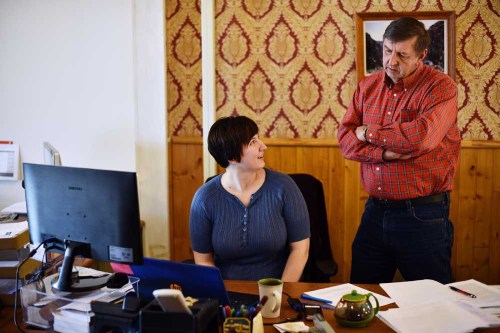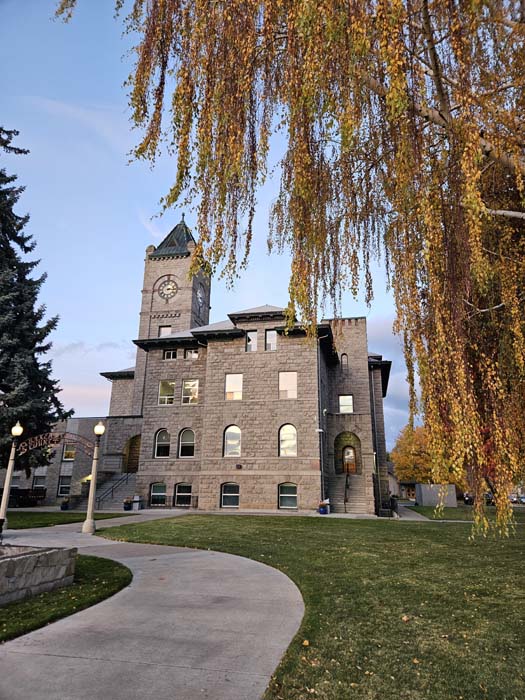Tiny newspaper bucks a trend
Published 3:56 pm Friday, April 20, 2018

- Publisher Les Zaitz looks over mug shots for a story with reporter Jayme Fraser on Monday at the Malheur Enterprise in Vale.
Les Zaitz was on a glide path toward retirement.
No one could blame him for thinking about powering down. He had racked up some remarkable accomplishments during his journalism career. Some 44 years ago, Zaitz jumped into journalism right out of high school, starting at the Salem Statesman Journal and eventually maturing into the Oregonian’s senior investigative reporter. The two-time Pulitzer finalist raked in scores of journalism prizes.
A couple of years ago, Zaitz envisioned retiring with his wife, Scotta Callister, at their Grant County ranch. He would ride horses and fix fence and maybe write a book.
Instead, he doubled down on journalism.
It all started when someone told him the Malheur Enterprise was for sale. The tiny newspaper in Vale, a town of fewer than 2,000 people, was on the verge of going under. That troubled Zaitz.
“I realized, here’s this paper that’s been here 100 years,” he said. “I’m a big believer in community newspapers and could not buy the idea that it could just shut down.”
He appealed to his wife, who had just retired from her job as editor of the Blue Mountain Eagle in John Day, and his brother Lyndon Zaitz, publisher of the Keizertimes. The trio bought the newspaper in October 2015 and set about turning it around.
“The paper in my judgment at that time was arguably the worst newspaper in Oregon,” Zaitz said. “It was full of government press releases.”
Over the next two years, the newspaper morphed into a tiny powerhouse. This month, the weekly won a national writing award, beating out such industry giants as the New York Times and the Washington Post. Circulation has seen healthy growth. By summer, Zaitz will have five reporters, up from one, including two summer interns from the University of Oregon.
Zaitz looks at the little weekly as something of a laboratory. Sitting at a table in the newspaper’s break room, he explained how the Enterprise is bucking the trend in a time of shrinking and dying newspapers.
“I’ve always been struck that as the newspaper industry went through grinding change in the past decade everyone was struggling for answers and the answers typically came from major news organizations,” he said. “The rest of us were just expected to scale down what they were doing to fit our operations. Well, what if we turned that around? There are a hell of a lot more smaller newsrooms than big ones in the country.”
Zaitz insists the newspaper’s transformation wasn’t magic, it was simply gaining the trust of readers by giving them what they want.
Because Zaitz still worked at the Oregonian, Callister ran the paper the first year. She got rid of press releases that masqueraded as news. She added an editorial page, improved the format and made other “nuts and bolts” changes.
About a year and a half ago, Zaitz retired from the Oregonian and came on the scene like a tsunami hitting the beach. Callister re-retired to the ranch.
Pat Caldwell, one the paper’s two reporters, said Zaitz was a force from day one.
“He was like Jimmie Johnson when he took over the Cowboys,” Caldwell recalled. “He said, ‘We’re going to turn this thing around. We’re not going to be a sleepy weekly. We’re going to be a powerhouse.’”
Caldwell remembers feeling a tad dubious, but willing to follow the lead of his new boss. No rookie, Caldwell has more than 20 years of experience as reporter, editor and combat correspondent who was published all over the world. The 51-year-old had been working as a successful freelancer when he was invited to fill in after the paper’s only reporter at the time, John Braese, fell gravely ill. When Braese returned months later, Caldwell was offered a full-time job. He embraced it as a way to learn at the knee of a two-time Pulitzer finalist.
“From the very beginning he said to us, ‘We’re going to be the best there ever was,’” Caldwell said. “We needed to get on board. So we did.”
Caldwell remembers turning in stories “that would have flown anywhere else” and getting them handed back.
“The first three months were the equivalent of basic training,” he said. “I’ve learned more in a year and a half under Les than I’ve learned in my entire career.”
In early 2017, the news team uncovered a story of a man who had faked insanity to avoid prison for kidnapping. After release from the Oregon State Hospital (despite reservations by a state psychiatrist), Anthony Montwheeler allegedly kidnapped and stabbed his ex-wife to death in his pickup. A Vale man died in a collision during the police pursuit of Montwheeler. In the course of the Enterprise investigation, Zaitz pressed the state psychiatric board to provide 218 exhibits presented at Montwheeler’s Psychiatric Security Review Board evaluation hearing. Oregon Attorney General Ellen Rosenblum ordered the release of records. But instead of providing them, the board sued the Enterprise, which responded by crowdsourcing the $20,000 needed for defense and hiring an attorney. The board relented after Gov. Kate Brown argued “no one requesting public records should be at risk of being sued by a state agency.”
Zaitz encapsulated several months of investigation into the story, “Deadly Decisions.” Investigative Reporters and Editors this month awarded its FOI (freedom of information) Award to the Enterprise team of Zaitz, Braese and Caldwell. The honor marked the first time in the 20-year history of the award that the national news organization honored a community newspaper.
As another perk of the paper’s investigative success, Pro Publica is financing a full-time reporter for a year, so the team can ramp up its investigations. The arrival of Jayme Fraser bumps the number of reporters to three.
Braese, the only holdover from the previous owner, marvels at the metamorphosis of the Enterprise. He remembers the days he shared a tiny hallway-shaped space in a former Idaho Power pay station with three staff members.
“Basically four of us were within 10 feet of each other. You could reach out and touch everybody,” Braese said. “There were times I’d announce I have a phone interview to do and please everybody be quiet for the next 10 minutes.”
Braese did the best he could, Zaitz said, covering sports, attending meetings, rewriting press releases and keeping in contact with the Tacoma-based former music critic that owned the paper at the time. But it was a losing battle.
These days, based out of a bigger building, the reporters don’t waste time covering meetings, rather developing their sources enough to know in advance what may happen. They concentrate on stories about issues, such as a recent series on the foster care system.
“It’s truly amazing in an era where we see dailies cutting staff and reports of massive layoffs at this paper or that paper that a weekly in such a small area has taken such a new direction in newspapers and is not only remaining stable, but actually expanding,” Braese said. “Truthfully, we’re the model that maybe the Post and the Times might be looking at, rather than laying off and hoping it gets better down the road.”
The Enterprise strategy seems to be working. The newspaper is nimble enough to pivot quickly if readers respond negatively to something.
“I wondered if we could be in some small way an inspiration for others to not give up,” Zaitz said. “Yeah, newspapers are losing resources, but good Lord, if I can do it in Vale, then you can’t come to me and complain you don’t have enough resources in Pendleton, Bend, Cincinnati, Orlando.”
Overseeing it all is Zaitz, who keeps his reporters cranking. The first thing Caldwell does when he gets up every morning is check his email for messages from Zaitz, some sent hours earlier.
“I don’t want to say he’s like a mad scientist, but he’s got these ideas coming all the time,” Caldwell said. “He’ll be like, you know that guy did this and I bet it’s connected to this and we need to call these people and those people.”
Zaitz may retire — someday. He admitted that if he won the state lottery, he might use it to buy more newspapers. His wife doesn’t expect him full-time at the ranch any time soon.
“It’s been a great ride for him,” Callister said. “He loves a challenge and he’s having so much fun. He’s not good at retirement.”
———
Contact Kathy Aney at kaney@eastoregonian.com or 541-966-0810.





